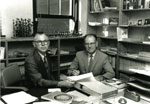
Back in Pasadena after his year abroad, David helped complete the arduous work on threonine and solved the structure of DL-serine [D.P. Shoemaker, R. E. Barieau, J. Donohue and C.-S. Lu (1953). Acta Cryst. 6, 241-256], which had previously stumped the laboratory. He also began what became his main research career, on the structures of complex transition-metal phases, with the discovery of the -phase structure with 'his' (officially Pauling's) student B. Gunnar Bergman. With Clara and their associates at MIT, and later at Oregon State, he continued to work out and publish a long list of related structures.
These transition-metal alloy structures with only tetrahedral interstices ('tetrahedrally close packed') later became important as possible storage materials for hydrogen, and a collaboration was established with the Crystallographic Laboratory of E. F. Bertaut in Grenoble. Structural principles, such as local approximate icosahedral symmetry and repetition of icosahedral orientation through linking of icosahedra, became of interest with the discovery of quasicrystals.
Early in his MIT career, David also began notable productive work on the structures of zeolites, which included derivations-discoveries of the structures of the commercially most important zeolites (A and X/Y-Faujasite). He also found time to write (with Carl W. Garland, Jeffrey I. Steinfeld and later Joseph W. Nibler) a widely used laboratory text Experiments in Physical Chemistry, now in its sixth edition. For the book Crystallography in North America, published in 1983 by the American Crystallographic Association, David wrote an engaging account of his MIT days that we recommend to all for further details. One charming paragraph, however, needs quoting.
'The decisive occurrence in the formation of my research group [at MIT] and in getting the new program going was the arrival in 1953 of Clara Brink, Ph.D. Leiden 1950, who had worked in the Laboratories of A. E. van Arkel, J. M. Bijvoet, Dorothy Hodgkin (on vitamin B12), and Caroline MacGillavry. Jack Dunitz, after meeting Clara in Holland and learning of her plans to come to my laboratory, is reported to have said to mutual acquaintances: "I have just met Dave Shoemaker's future wife!" Well it took two years for Dave Shoemaker to get the picture, but Jack's perceptivity was vindicated when the wedding took place in 1955.'


